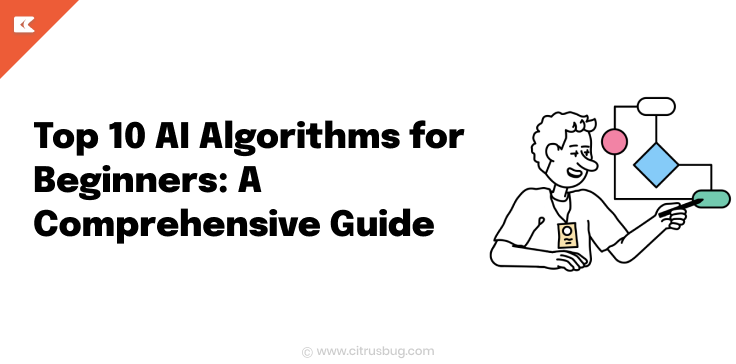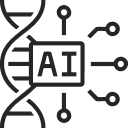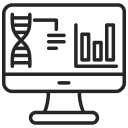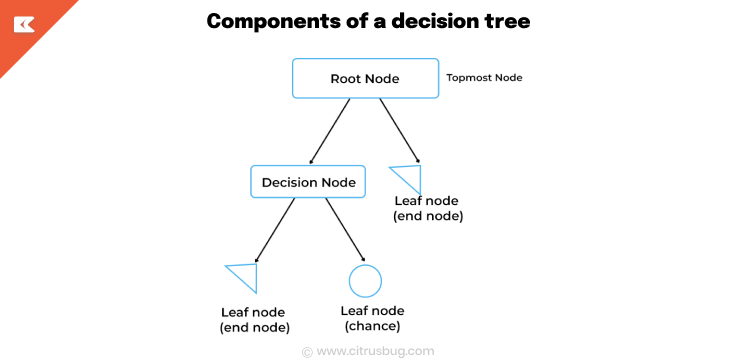Top 10 AI Algorithms for Beginners: A Comprehensive Guide (2025)
- August 31, 2024
-
5489 Views
- by Ishan Vyas

AI has quickly become integral to modern technologies, impacting sectors like health, banking, and more. The foundation of AI technology rests on algorithms that enable machines to learn. These algorithms help machines adapt to their environment and modify themselves accordingly. This allows for independent decision-making processes, essential for advanced AI applications.
Artificial intelligence has rapidly become one of the principal and game-changing forces in this fast-moving technological environment. It reshapes how we interact with digital tools and applications. With each new development, AI is shifting how app and software development works. Its additions enhance functionality, user experience, and performance. Strong algorithms lie at the very core of these innovations, driving intelligence behind the scenes. Anybody wanting to drive full potential in AI-based applications must master these top algorithms. In this article, we will discuss the top AI algorithms revolutionizing app development. We will also share insights into their workings and their impact on making applications and software smarter and more intuitive.
What is an AI Algorithm?
AI algorithms are sets of rules that tell computers how to look at data, do jobs, and make choices. It is a part of machine learning that tells computers how to learn and work on their own.
There are certain formulas that AI uses to do all of its work. When you turn on your computer and when you browse the internet, AI algorithms and other machine learning algorithms work together to do everything.
Computers can predict patterns, look at trends, figure out accuracy, and make processes run more smoothly with the help of AI and machine learning algorithms.
How do AI Algorithms Work?
AI algorithms operate by taking in data, processing it, and learning from it to make predictions or decisions. The process starts with gathering and cleaning the data, then pulling out important details that help the algorithm understand the problem. Researchers choose the right algorithm for the task at hand and train the model on this data to recognize patterns. After training, they test the model to ensure it performs well with new, unseen data. Once ready, the algorithm starts making predictions and improves over time as it learns from new information.
Top 10 AI Algorithms You Should Know in 2025
1. Linear Regression
A supervised learning technique called linear regression is used to anticipate and predict data, such as prices or sales figures, that fall within a continuous range.
Linear regression is a statistical technique that predicts a numerical value or quantity by mapping an input value (X) with a variable output (Y) at a constant slope. By approximating a line of greatest fit, or “regression line,” from a scatter plot of data points, linear regression uses labelled data to generate predictions. Therefore, rather than using categorization for predictive modelling, linear regression is used.
2. Logistic Regression
Logistic regression is a data analysis technique that uses mathematics to find the relationships between two data factors. It then uses this relationship to predict the value of one of those factors based on the other. The prediction usually has a finite number of outcomes, like yes or no.
For example, suppose you want to predict if a visitor will click the checkout button in their cart. Logistic regression analysis examines past visitor behaviour, like time spent on the website. It also considers the number of items in the cart. The analysis shows that visitors who spend more than five minutes and add three items typically click checkout. Using this information, the logistic regression function can then predict the behaviour of a new website visitor.
3. Q-learning
Q-learning is a model-free, value-based, off-policy algorithm for reinforcement learning that will find the best series of actions based on the current state. The “Q” stands for quality. Quality represents how valuable the action is in maximizing future rewards. Q-learning is essentially learning by experience. Q-learning often combines with deep neural networks, using convolutional neural networks to extract features from video frames, such as teaching a computer to play video games or learning robotic control. Google DeepMind successfully trained AlphaGo and AlphaZero, famous game-playing programs, by combining reinforcement learning with deep neural networks.
4. Decision Trees
The Decision Tree is a type of supervised learning algorithm that is capable of tackling both classification and regression issues. However, researchers primarily favor it for addressing classification difficulties. The classifier organizes itself in a tree structure, with core nodes representing dataset attributes, branches representing decision rules, and each leaf node representing an outcome.
A Decision tree consists of two types of nodes: the Decision Node and the Leaf Node. Decision nodes are utilised for making decisions and possess numerous branches, while Leaf nodes serve as the output of such decisions and do not possess any other branches.
5. K-Nearest Neighbors
K Nearest Neighbor (KNN) is a simple, understandable, and adaptable AI algorithm. It’s utilized in a variety of applications, including handwriting detection, picture recognition, and video recognition. KNN is most beneficial when labelled data is prohibitively expensive or impossible to gather, and it can perform well in a wide range of prediction situations.
KNN is a simple AI algorithm that uses the target function’s local minimum to learn an unknown function with the appropriate precision and accuracy. The technique also determines an unknown input’s neighbourhood, range, or distance from it, as well as other factors. It works on the premise of “information gain”—the algorithm determines which is best suited to predicting an unknown number.
6. Random Decision Forests
Random Forest is a popular machine learning algorithm that belongs to the supervised learning technique. It can be applied to ML issues involving both classification and regression. Its foundation is the idea of ensemble learning, which is the process of merging several classifiers to solve a challenging issue and enhance the model’s functionality.
As the name suggests, “Random Forest is a classifier that contains a number of decision trees on various subsets of the given dataset and takes the average to improve the predictive accuracy of that dataset.” Rather than depending on a single decision tree, the random forest forecasts the outcome based on the majority vote of projections from each tree
7. Deep Neural Networks
Deep neural networks can recognize voice commands, identify voices, recognize sounds and graphics and do much more than a neural network. It utilize “Big Data” along with algorithms in order to solve a problem, and these deep neural networks can solve problems with limited or no human input.
8. Diffusion Models
Diffusion models are AI algorithms that generate high-quality data by gradually introducing noise to a dataset and subsequently learning to reverse this process. This novel method enables them to generate outputs that are remarkably detailed and accurate, producing everything from coherent text sequences to realistic images. Their function relies on the fundamental concept of progressively deteriorating data quality, which they then reconstruct to its original form or transform into something new. This method improves the accuracy of the data produced and presents novel opportunities in fields such as personalized AI assistants, autonomous vehicles, and medical imaging.
Diffusion models work in a dual-phase mechanism: They first train a neural network to introduce noise into the dataset(a staple in the forward diffusion process) and then methodically reverse this process.
9. Naive Bayes
Naive Bayes classifiers are an assortment of simple and powerful classification AI algorithms based on the Bayes Theorem. They are recommended as a first approach to classify complicated datasets before more refined classifiers are used.
There are three types of naive Bayes classifiers.
1) Gaussian Naive Bayes Classifiers
2)Bernoulli Naive Bayes Classifiers
3) Multinomial Naive Bayes Classifiers
Naive Bayes algorithms are most commonly used for text classification. There are differences within these AI algorithms, but each is simple and efficient. While each algorithm would need training data to approximate the parameters needed for evaluation, the Naive Bayes algorithm can give required data quicker than more sophisticated methods, making them valuable in real-world situations.
10. Dimensionality Reduction Algorithms
Dimensionality reduction refers to the method of reducing variables in a training dataset used to develop machine learning models. The process keeps a check on the dimensionality of data by projecting high dimensional data to a lower dimensional space that encapsulates the ‘core essence’ of the data.
Machine learning requires many sources and computations to analyze data with millions of features. Besides, it also involves a lot of manual labour. Dimensionality reduction makes this complex task relatively easy by converting a high-dimensional dataset to a lower-dimensional dataset without affecting the key properties of the original dataset. This process reveals the data pre-processing steps undertaken before beginning the training cycle of machine learning models.
Conclusion
All the while, these basic top AI algorithms are crucial for the implementation and growth of the AI industry. Despite their simplicity, these top 10 AI algorithms remain important in 2025. Decision trees, for instance, can be used to classify data into different groups or clusters based on certain metrics such as weight, age, and colour. These algorithms have gained importance mainly due to their simplicity. For any AI software development company, understanding them well is essential for success in this rapidly evolving field.
As such, these new-wave AI technologies present both hopes and fears—on one hand, they can lead us toward a better future, while on the other hand, they can cause more harm than good. The complexity of the problem is steadily increasing.





 SaaS Development
SaaS Development Web Application Development
Web Application Development Mobile Application Development
Mobile Application Development Custom Software Development
Custom Software Development Cloud Development
Cloud Development DevOps Development
DevOps Development MVP Development
MVP Development Digital Product Development
Digital Product Development Hire Chatbot Developers
Hire Chatbot Developers Hire Python Developers
Hire Python Developers Hire Django Developers
Hire Django Developers Hire ReactJS Developers
Hire ReactJS Developers Hire AngularJS Developers
Hire AngularJS Developers Hire VueJS Developers
Hire VueJS Developers Hire Full Stack Developers
Hire Full Stack Developers Hire Back End Developers
Hire Back End Developers Hire Front End Developers
Hire Front End Developers AI Healthcare Software Development & Consulting
AI Healthcare Software Development & Consulting Healthcare App Development
Healthcare App Development EHR Software Development
EHR Software Development Healthcare AI Chatbot Development
Healthcare AI Chatbot Development Telemedicine App Development Company
Telemedicine App Development Company Medical Billing Software Development
Medical Billing Software Development Fitness App Development
Fitness App Development RPM Software Development
RPM Software Development Medicine Delivery App Development
Medicine Delivery App Development Medical Device Software Development
Medical Device Software Development Patient Engagement Software Solutions
Patient Engagement Software Solutions Mental Health App Development
Mental Health App Development Healthcare IT Consulting
Healthcare IT Consulting Healthcare CRM Software Development
Healthcare CRM Software Development Healthcare IT Managed Services
Healthcare IT Managed Services Healthcare Software Testing services
Healthcare Software Testing services Medical Practice Management Software
Medical Practice Management Software Outsourcing Healthcare IT Services
Outsourcing Healthcare IT Services IoT Solutions for Healthcare
IoT Solutions for Healthcare Medical Image Analysis Software Development Services
Medical Image Analysis Software Development Services Lending Software Development Services
Lending Software Development Services Payment Gateway Software Development
Payment Gateway Software Development Accounting Software Development
Accounting Software Development AI-Driven Banking App Development
AI-Driven Banking App Development Insurance Software Development
Insurance Software Development Finance Software Development
Finance Software Development Loan Management Software Development
Loan Management Software Development Decentralized Finance Development Services
Decentralized Finance Development Services eWallet App Development
eWallet App Development Payment App Development
Payment App Development Money Transfer App Development
Money Transfer App Development Mortgage Software Development
Mortgage Software Development Insurance Fraud Detection Software Development
Insurance Fraud Detection Software Development Wealth Management Software Development
Wealth Management Software Development Cryptocurrency Exchange Platform Development
Cryptocurrency Exchange Platform Development Neobank App Development
Neobank App Development Stock Trading App Development
Stock Trading App Development AML software Development
AML software Development Web3 Wallet Development
Web3 Wallet Development Robo-Advisor App Development
Robo-Advisor App Development Supply Chain Management Software Development
Supply Chain Management Software Development Fleet Management Software Development
Fleet Management Software Development Warehouse Management Software Development
Warehouse Management Software Development LMS Development
LMS Development Education App Development
Education App Development Inventory Management Software Development
Inventory Management Software Development Property Management Software Development
Property Management Software Development Real Estate CRM Software Development
Real Estate CRM Software Development Real Estate Document Management Software
Real Estate Document Management Software Construction App Development
Construction App Development Construction ERP Software Development
Construction ERP Software Development





